International Relations of Southeast Asia
VerifiedAdded on 2023/03/20
|11
|3304
|42
AI Summary
This article discusses the potential and capacity of ASEAN to be a diplomatic actor in East Asia. It explores the role of ASEAN in negotiating social roles, promoting dialogue, and fostering regional peace. The article also highlights the importance of ASEAN in the context of East Asian regional security architecture.
Contribute Materials
Your contribution can guide someone’s learning journey. Share your
documents today.

Running head: INTERNATIONAL RELATIONS OF SOUTHEAST ASIA
INTERNATIONAL RELATIONS OF SOUTHEAST ASIA
Name of the Student:
Name of the University:
Author note:
INTERNATIONAL RELATIONS OF SOUTHEAST ASIA
Name of the Student:
Name of the University:
Author note:
Secure Best Marks with AI Grader
Need help grading? Try our AI Grader for instant feedback on your assignments.

1
INTERNATIONAL RELATIONS OF SOUTHEAST ASIA
Answer 6
In a provincemainly bereft of regional administrationsas well as long separated by Cold
War, the Association of Southeast Asian Nations (ASEAN) has been regarded as the most
noteworthymultidimensional association since the last four decades. Sincethe Cold War has
ended, ASEAN has developed rapidly decisive. While considerableproportion of the West and
expanding markets tend to suffer due to global recession of 2008, the prominent ASEAN
economies have improved and have been gradually developing1. Studies of Misalucha-
Willoughby (2018) have noted that ASEAN has aided Southeast Asia to prevent from any
interstate conflicts regardless of several brewing territorial disputes in the region. Considering its
size with a populace of more than 640 million, substantial shared economic loadand powerful
affiliates like Indonesia and Singapore, ASEAN has developed the capacity to develop high
decisiveness. Pagovski (2015) has noted that if it had borders that are more open and liberated
intra-ASEAN business, it could appeal to significant investment, enhance its competitiveness in
anarray of industries also serve contributory role in global commercial and trade forums2.
According to Yates (2017), an authorized ASEAN Secretariat has the competence to deal with
diplomatic, financial and security challenges in a highly destructive as well as comprehensive
manner3. The following paper will discuss about the potential and capacity of ASEAN to be a
diplomatic actor in East Asia.
Discussion
1Misalucha-Willoughby, Charmaine. How to change the game of security cooperation: The case of the ASEAN-
China strategic partnership. No. 121/2018. Working Papers on East Asian Studies, 2018.
2Pagovski, Zhikica Zach. "Public Diplomacy of Multilateral Organizations: The Cases of NATO, EU, and
ASEAN." Los Angeles, Figueroa Press 51 (2015): 61.
3Pagovski, Zhikica Zach. "Public Diplomacy of Multilateral Organizations: The Cases of NATO, EU, and
ASEAN." Los Angeles, Figueroa Press 51 (2015): 61.
INTERNATIONAL RELATIONS OF SOUTHEAST ASIA
Answer 6
In a provincemainly bereft of regional administrationsas well as long separated by Cold
War, the Association of Southeast Asian Nations (ASEAN) has been regarded as the most
noteworthymultidimensional association since the last four decades. Sincethe Cold War has
ended, ASEAN has developed rapidly decisive. While considerableproportion of the West and
expanding markets tend to suffer due to global recession of 2008, the prominent ASEAN
economies have improved and have been gradually developing1. Studies of Misalucha-
Willoughby (2018) have noted that ASEAN has aided Southeast Asia to prevent from any
interstate conflicts regardless of several brewing territorial disputes in the region. Considering its
size with a populace of more than 640 million, substantial shared economic loadand powerful
affiliates like Indonesia and Singapore, ASEAN has developed the capacity to develop high
decisiveness. Pagovski (2015) has noted that if it had borders that are more open and liberated
intra-ASEAN business, it could appeal to significant investment, enhance its competitiveness in
anarray of industries also serve contributory role in global commercial and trade forums2.
According to Yates (2017), an authorized ASEAN Secretariat has the competence to deal with
diplomatic, financial and security challenges in a highly destructive as well as comprehensive
manner3. The following paper will discuss about the potential and capacity of ASEAN to be a
diplomatic actor in East Asia.
Discussion
1Misalucha-Willoughby, Charmaine. How to change the game of security cooperation: The case of the ASEAN-
China strategic partnership. No. 121/2018. Working Papers on East Asian Studies, 2018.
2Pagovski, Zhikica Zach. "Public Diplomacy of Multilateral Organizations: The Cases of NATO, EU, and
ASEAN." Los Angeles, Figueroa Press 51 (2015): 61.
3Pagovski, Zhikica Zach. "Public Diplomacy of Multilateral Organizations: The Cases of NATO, EU, and
ASEAN." Los Angeles, Figueroa Press 51 (2015): 61.

2
INTERNATIONAL RELATIONS OF SOUTHEAST ASIA
There is mounting evidence for the fact that ASEAN has played a crucial role in
negotiating genuine social roles by acting in the form of a ‘primary administrator’ in Southeast
Asia and has effectively adorned the roles and responsibilities of being a ‘regional conductor’ in
Asia-Pacific. The key role of ASEAN in diplomacy can be accredited to the presence of three
distinct and definite periods namely, (i) 1954–1975 when the role of primary manager for
ASEAN emerged, following conducting consultations with the USA, (ii) 1978–1991 when the
role got further reinforced by participating in negotiations and discussions with China, at the
time of Cambodian conflict, and (iii) 1991-current when the role of a regional conductor got
created and advanced by the ASEAN4. The aforementioned negotiations conducted with other
nations helped in the establishment of appropriate division of labour. This in turn facilitated the
great powers to provide the much needed security to public goods. In addition, the negotiations
also promoted the transfer of the roles of diplomatic control to ASEAN.
Its role as a primary diplomatic actor can also be associated to the fact that ASEAN holds
the capability of sustaining the roles and responsibilities, by effectively preserving and upholding
role bargains that are tolerable and conventional to the great powers. This in turn is a
progressively difficult job due to the existence of great power competition in South China Sea.
Presence of adequate diplomacy skills also allows the ASEAN leaders to effectively
communicate, without being involved in any circumstance that are marked by bringing the
negotiations and considerations into the community view5. The role of ASEAN as a diplomatic
actor can also be associated to the presence of the ASEAN Regional Forum (ARF) that met in
1994 for the first time, and has taken considerable efforts in fostering positive dialogue and
4Yates, Robert. "ASEAN as the ‘regional conductor’: understanding ASEAN's role in Asia-Pacific order." The
Pacific Review 30, no. 4 (2017): 443-461.
5Yates, Robert. Understanding ASEAN's Role in Asia-Pacific Order. Springer Nature, 2019.
INTERNATIONAL RELATIONS OF SOUTHEAST ASIA
There is mounting evidence for the fact that ASEAN has played a crucial role in
negotiating genuine social roles by acting in the form of a ‘primary administrator’ in Southeast
Asia and has effectively adorned the roles and responsibilities of being a ‘regional conductor’ in
Asia-Pacific. The key role of ASEAN in diplomacy can be accredited to the presence of three
distinct and definite periods namely, (i) 1954–1975 when the role of primary manager for
ASEAN emerged, following conducting consultations with the USA, (ii) 1978–1991 when the
role got further reinforced by participating in negotiations and discussions with China, at the
time of Cambodian conflict, and (iii) 1991-current when the role of a regional conductor got
created and advanced by the ASEAN4. The aforementioned negotiations conducted with other
nations helped in the establishment of appropriate division of labour. This in turn facilitated the
great powers to provide the much needed security to public goods. In addition, the negotiations
also promoted the transfer of the roles of diplomatic control to ASEAN.
Its role as a primary diplomatic actor can also be associated to the fact that ASEAN holds
the capability of sustaining the roles and responsibilities, by effectively preserving and upholding
role bargains that are tolerable and conventional to the great powers. This in turn is a
progressively difficult job due to the existence of great power competition in South China Sea.
Presence of adequate diplomacy skills also allows the ASEAN leaders to effectively
communicate, without being involved in any circumstance that are marked by bringing the
negotiations and considerations into the community view5. The role of ASEAN as a diplomatic
actor can also be associated to the presence of the ASEAN Regional Forum (ARF) that met in
1994 for the first time, and has taken considerable efforts in fostering positive dialogue and
4Yates, Robert. "ASEAN as the ‘regional conductor’: understanding ASEAN's role in Asia-Pacific order." The
Pacific Review 30, no. 4 (2017): 443-461.
5Yates, Robert. Understanding ASEAN's Role in Asia-Pacific Order. Springer Nature, 2019.

3
INTERNATIONAL RELATIONS OF SOUTHEAST ASIA
discussion with other nations, and has also promoted building of confidence, thereby preventing
diplomacy in the province. ASEAN also participates in meetings with European nations during
Asia–Europe Meeting (ASEM), whereby exchange of informal dialogues has helped it to
strengthen cooperation between the republics, thus promoting diplomacy6.
Meanwhile, as per the view of Pagovski (2015), in its way to shared goals and problems
that have resulted to critical confrontations and encounter, ASEAN has put utmost emphasis on
dialogue and discussionrather than supportingexaggeration, conflict and confrontation. The
primary practice of integrating the ASEAN economy intended mainly at dynamic efficiency,
undemanding and less expensive trade and business7. Reports of RatihIndraswari(2015) have
noted that ASEAN through its diplomatic process has stimulated the implementations of the
ASEAN Free Trade Area (AFTA), which has been embarking on conflicts and consultations on
the liberalization of commerce in service encompassing all service sectors along with all modes
of supply. ASEAN collaboration in several other areas has reinforced the consistency of
regionalism and strengthened the regional distinctiveness of Southeast Asia, which
consequentlyelevated the stake in regional peace and progress. According to Mathew (2016),
ASEAN cooperation has significantly continued on amounting range of endeavoursrelated to
employment, education and health, environmental protection, social safety associations and the
family, large-scalecorruption, science and technology, rural growth, illegal activities, food and
agriculture, labour in addition to the status of women along with small and medium enterprises8.
6Pagovski, Zhikica Zach. "Public Diplomacy of Multilateral Organizations: The Cases of NATO, EU, and
ASEAN." Los Angeles, Figueroa Press 51 (2015): 61.
7Ma, RatihIndraswari. "Cultural Diplomacy in ASEAN: Collaborative Efforts." International Journal of Social
Science and Humanity 5, no. 4 (2015): 394.
8Caballero-Anthony, Mely. "Understanding ASEAN's centrality: bases and prospects in an evolving regional
architecture." The Pacific Review 27, no. 4 (2014): 563-584.
INTERNATIONAL RELATIONS OF SOUTHEAST ASIA
discussion with other nations, and has also promoted building of confidence, thereby preventing
diplomacy in the province. ASEAN also participates in meetings with European nations during
Asia–Europe Meeting (ASEM), whereby exchange of informal dialogues has helped it to
strengthen cooperation between the republics, thus promoting diplomacy6.
Meanwhile, as per the view of Pagovski (2015), in its way to shared goals and problems
that have resulted to critical confrontations and encounter, ASEAN has put utmost emphasis on
dialogue and discussionrather than supportingexaggeration, conflict and confrontation. The
primary practice of integrating the ASEAN economy intended mainly at dynamic efficiency,
undemanding and less expensive trade and business7. Reports of RatihIndraswari(2015) have
noted that ASEAN through its diplomatic process has stimulated the implementations of the
ASEAN Free Trade Area (AFTA), which has been embarking on conflicts and consultations on
the liberalization of commerce in service encompassing all service sectors along with all modes
of supply. ASEAN collaboration in several other areas has reinforced the consistency of
regionalism and strengthened the regional distinctiveness of Southeast Asia, which
consequentlyelevated the stake in regional peace and progress. According to Mathew (2016),
ASEAN cooperation has significantly continued on amounting range of endeavoursrelated to
employment, education and health, environmental protection, social safety associations and the
family, large-scalecorruption, science and technology, rural growth, illegal activities, food and
agriculture, labour in addition to the status of women along with small and medium enterprises8.
6Pagovski, Zhikica Zach. "Public Diplomacy of Multilateral Organizations: The Cases of NATO, EU, and
ASEAN." Los Angeles, Figueroa Press 51 (2015): 61.
7Ma, RatihIndraswari. "Cultural Diplomacy in ASEAN: Collaborative Efforts." International Journal of Social
Science and Humanity 5, no. 4 (2015): 394.
8Caballero-Anthony, Mely. "Understanding ASEAN's centrality: bases and prospects in an evolving regional
architecture." The Pacific Review 27, no. 4 (2014): 563-584.
Secure Best Marks with AI Grader
Need help grading? Try our AI Grader for instant feedback on your assignments.
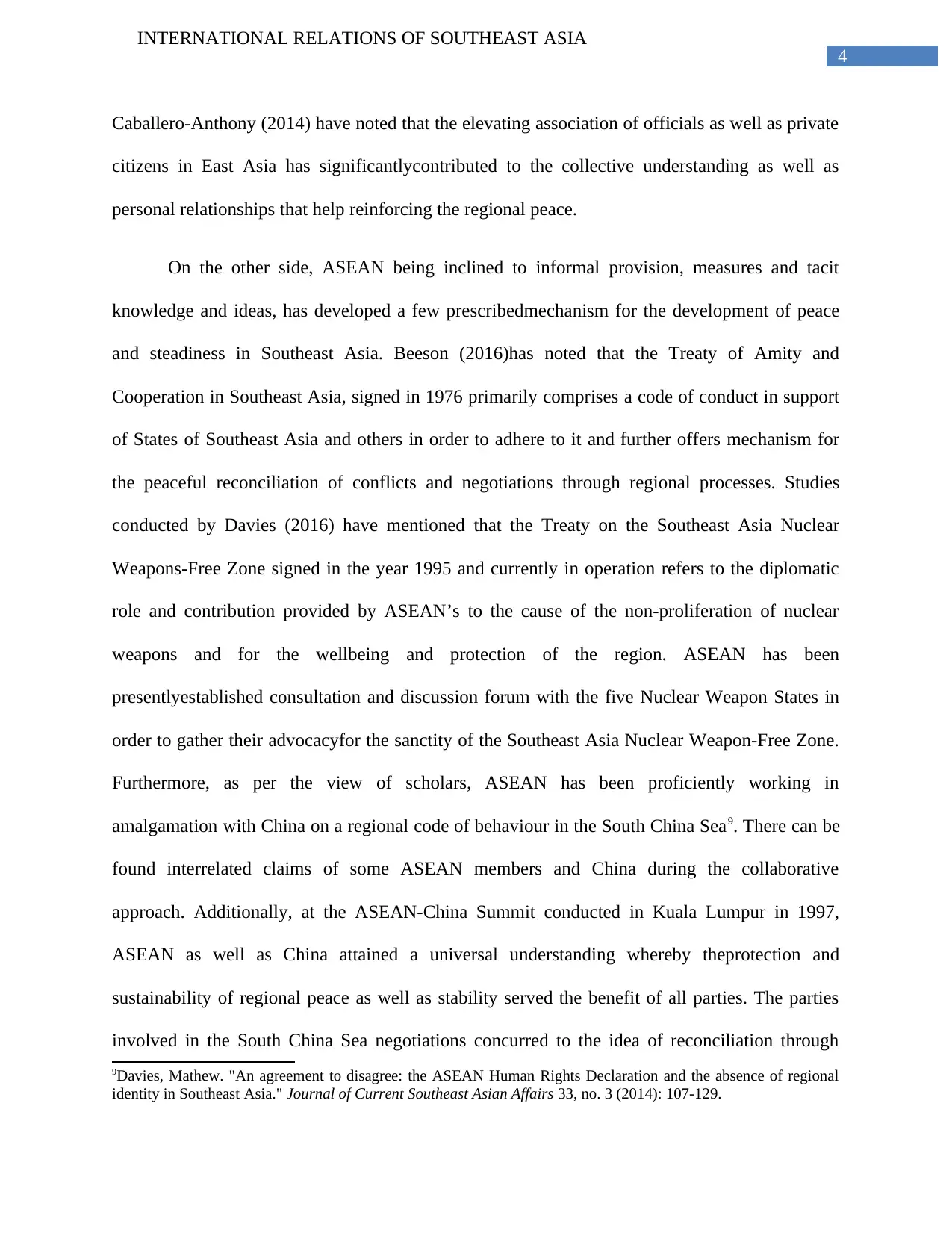
4
INTERNATIONAL RELATIONS OF SOUTHEAST ASIA
Caballero-Anthony (2014) have noted that the elevating association of officials as well as private
citizens in East Asia has significantlycontributed to the collective understanding as well as
personal relationships that help reinforcing the regional peace.
On the other side, ASEAN being inclined to informal provision, measures and tacit
knowledge and ideas, has developed a few prescribedmechanism for the development of peace
and steadiness in Southeast Asia. Beeson (2016)has noted that the Treaty of Amity and
Cooperation in Southeast Asia, signed in 1976 primarily comprises a code of conduct in support
of States of Southeast Asia and others in order to adhere to it and further offers mechanism for
the peaceful reconciliation of conflicts and negotiations through regional processes. Studies
conducted by Davies (2016) have mentioned that the Treaty on the Southeast Asia Nuclear
Weapons-Free Zone signed in the year 1995 and currently in operation refers to the diplomatic
role and contribution provided by ASEAN’s to the cause of the non-proliferation of nuclear
weapons and for the wellbeing and protection of the region. ASEAN has been
presentlyestablished consultation and discussion forum with the five Nuclear Weapon States in
order to gather their advocacyfor the sanctity of the Southeast Asia Nuclear Weapon-Free Zone.
Furthermore, as per the view of scholars, ASEAN has been proficiently working in
amalgamation with China on a regional code of behaviour in the South China Sea9. There can be
found interrelated claims of some ASEAN members and China during the collaborative
approach. Additionally, at the ASEAN-China Summit conducted in Kuala Lumpur in 1997,
ASEAN as well as China attained a universal understanding whereby theprotection and
sustainability of regional peace as well as stability served the benefit of all parties. The parties
involved in the South China Sea negotiations concurred to the idea of reconciliation through
9Davies, Mathew. "An agreement to disagree: the ASEAN Human Rights Declaration and the absence of regional
identity in Southeast Asia." Journal of Current Southeast Asian Affairs 33, no. 3 (2014): 107-129.
INTERNATIONAL RELATIONS OF SOUTHEAST ASIA
Caballero-Anthony (2014) have noted that the elevating association of officials as well as private
citizens in East Asia has significantlycontributed to the collective understanding as well as
personal relationships that help reinforcing the regional peace.
On the other side, ASEAN being inclined to informal provision, measures and tacit
knowledge and ideas, has developed a few prescribedmechanism for the development of peace
and steadiness in Southeast Asia. Beeson (2016)has noted that the Treaty of Amity and
Cooperation in Southeast Asia, signed in 1976 primarily comprises a code of conduct in support
of States of Southeast Asia and others in order to adhere to it and further offers mechanism for
the peaceful reconciliation of conflicts and negotiations through regional processes. Studies
conducted by Davies (2016) have mentioned that the Treaty on the Southeast Asia Nuclear
Weapons-Free Zone signed in the year 1995 and currently in operation refers to the diplomatic
role and contribution provided by ASEAN’s to the cause of the non-proliferation of nuclear
weapons and for the wellbeing and protection of the region. ASEAN has been
presentlyestablished consultation and discussion forum with the five Nuclear Weapon States in
order to gather their advocacyfor the sanctity of the Southeast Asia Nuclear Weapon-Free Zone.
Furthermore, as per the view of scholars, ASEAN has been proficiently working in
amalgamation with China on a regional code of behaviour in the South China Sea9. There can be
found interrelated claims of some ASEAN members and China during the collaborative
approach. Additionally, at the ASEAN-China Summit conducted in Kuala Lumpur in 1997,
ASEAN as well as China attained a universal understanding whereby theprotection and
sustainability of regional peace as well as stability served the benefit of all parties. The parties
involved in the South China Sea negotiations concurred to the idea of reconciliation through
9Davies, Mathew. "An agreement to disagree: the ASEAN Human Rights Declaration and the absence of regional
identity in Southeast Asia." Journal of Current Southeast Asian Affairs 33, no. 3 (2014): 107-129.
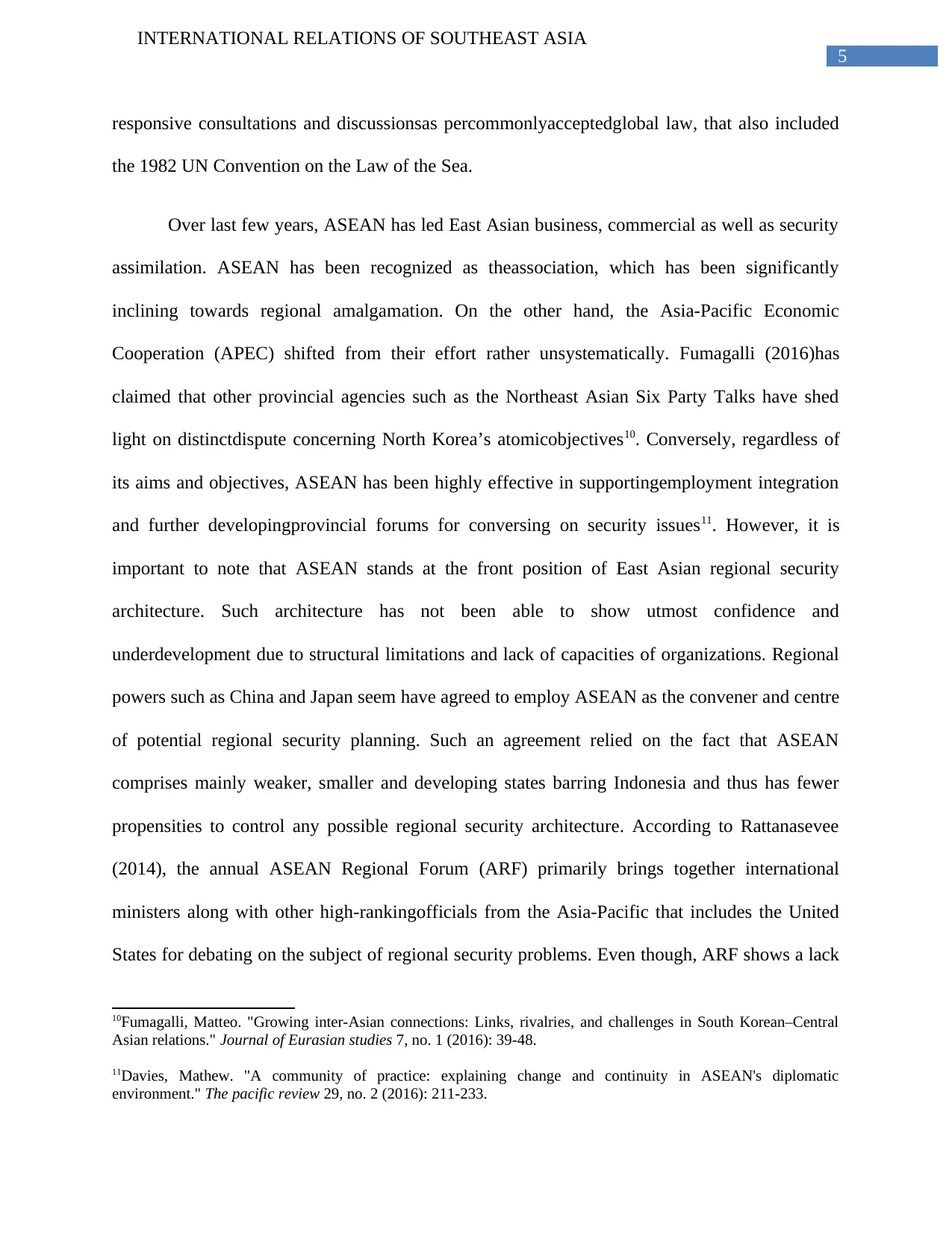
5
INTERNATIONAL RELATIONS OF SOUTHEAST ASIA
responsive consultations and discussionsas percommonlyacceptedglobal law, that also included
the 1982 UN Convention on the Law of the Sea.
Over last few years, ASEAN has led East Asian business, commercial as well as security
assimilation. ASEAN has been recognized as theassociation, which has been significantly
inclining towards regional amalgamation. On the other hand, the Asia-Pacific Economic
Cooperation (APEC) shifted from their effort rather unsystematically. Fumagalli (2016)has
claimed that other provincial agencies such as the Northeast Asian Six Party Talks have shed
light on distinctdispute concerning North Korea’s atomicobjectives10. Conversely, regardless of
its aims and objectives, ASEAN has been highly effective in supportingemployment integration
and further developingprovincial forums for conversing on security issues11. However, it is
important to note that ASEAN stands at the front position of East Asian regional security
architecture. Such architecture has not been able to show utmost confidence and
underdevelopment due to structural limitations and lack of capacities of organizations. Regional
powers such as China and Japan seem have agreed to employ ASEAN as the convener and centre
of potential regional security planning. Such an agreement relied on the fact that ASEAN
comprises mainly weaker, smaller and developing states barring Indonesia and thus has fewer
propensities to control any possible regional security architecture. According to Rattanasevee
(2014), the annual ASEAN Regional Forum (ARF) primarily brings together international
ministers along with other high-rankingofficials from the Asia-Pacific that includes the United
States for debating on the subject of regional security problems. Even though, ARF shows a lack
10Fumagalli, Matteo. "Growing inter-Asian connections: Links, rivalries, and challenges in South Korean–Central
Asian relations." Journal of Eurasian studies 7, no. 1 (2016): 39-48.
11Davies, Mathew. "A community of practice: explaining change and continuity in ASEAN's diplomatic
environment." The pacific review 29, no. 2 (2016): 211-233.
INTERNATIONAL RELATIONS OF SOUTHEAST ASIA
responsive consultations and discussionsas percommonlyacceptedglobal law, that also included
the 1982 UN Convention on the Law of the Sea.
Over last few years, ASEAN has led East Asian business, commercial as well as security
assimilation. ASEAN has been recognized as theassociation, which has been significantly
inclining towards regional amalgamation. On the other hand, the Asia-Pacific Economic
Cooperation (APEC) shifted from their effort rather unsystematically. Fumagalli (2016)has
claimed that other provincial agencies such as the Northeast Asian Six Party Talks have shed
light on distinctdispute concerning North Korea’s atomicobjectives10. Conversely, regardless of
its aims and objectives, ASEAN has been highly effective in supportingemployment integration
and further developingprovincial forums for conversing on security issues11. However, it is
important to note that ASEAN stands at the front position of East Asian regional security
architecture. Such architecture has not been able to show utmost confidence and
underdevelopment due to structural limitations and lack of capacities of organizations. Regional
powers such as China and Japan seem have agreed to employ ASEAN as the convener and centre
of potential regional security planning. Such an agreement relied on the fact that ASEAN
comprises mainly weaker, smaller and developing states barring Indonesia and thus has fewer
propensities to control any possible regional security architecture. According to Rattanasevee
(2014), the annual ASEAN Regional Forum (ARF) primarily brings together international
ministers along with other high-rankingofficials from the Asia-Pacific that includes the United
States for debating on the subject of regional security problems. Even though, ARF shows a lack
10Fumagalli, Matteo. "Growing inter-Asian connections: Links, rivalries, and challenges in South Korean–Central
Asian relations." Journal of Eurasian studies 7, no. 1 (2016): 39-48.
11Davies, Mathew. "A community of practice: explaining change and continuity in ASEAN's diplomatic
environment." The pacific review 29, no. 2 (2016): 211-233.
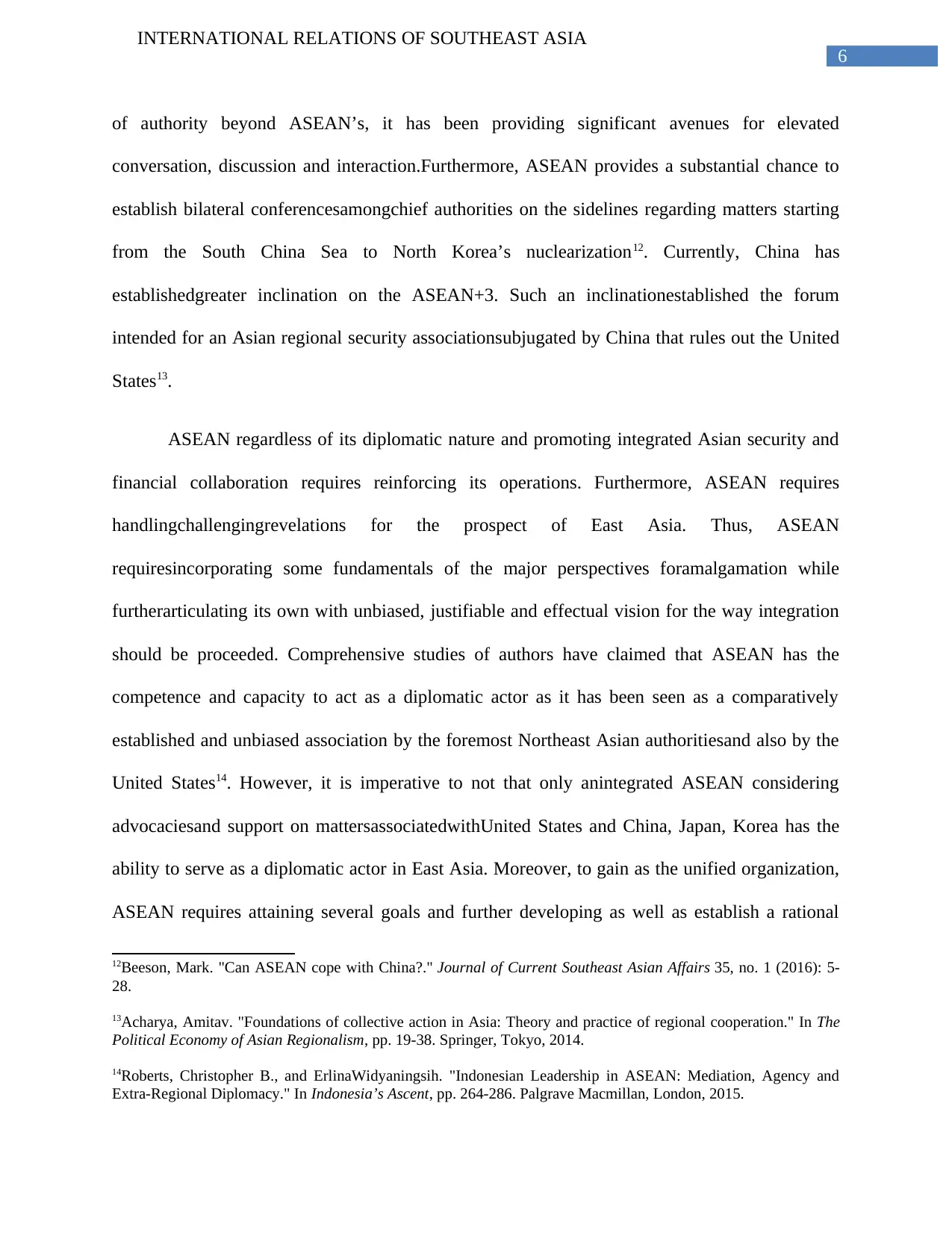
6
INTERNATIONAL RELATIONS OF SOUTHEAST ASIA
of authority beyond ASEAN’s, it has been providing significant avenues for elevated
conversation, discussion and interaction.Furthermore, ASEAN provides a substantial chance to
establish bilateral conferencesamongchief authorities on the sidelines regarding matters starting
from the South China Sea to North Korea’s nuclearization12. Currently, China has
establishedgreater inclination on the ASEAN+3. Such an inclinationestablished the forum
intended for an Asian regional security associationsubjugated by China that rules out the United
States13.
ASEAN regardless of its diplomatic nature and promoting integrated Asian security and
financial collaboration requires reinforcing its operations. Furthermore, ASEAN requires
handlingchallengingrevelations for the prospect of East Asia. Thus, ASEAN
requiresincorporating some fundamentals of the major perspectives foramalgamation while
furtherarticulating its own with unbiased, justifiable and effectual vision for the way integration
should be proceeded. Comprehensive studies of authors have claimed that ASEAN has the
competence and capacity to act as a diplomatic actor as it has been seen as a comparatively
established and unbiased association by the foremost Northeast Asian authoritiesand also by the
United States14. However, it is imperative to not that only anintegrated ASEAN considering
advocaciesand support on mattersassociatedwithUnited States and China, Japan, Korea has the
ability to serve as a diplomatic actor in East Asia. Moreover, to gain as the unified organization,
ASEAN requires attaining several goals and further developing as well as establish a rational
12Beeson, Mark. "Can ASEAN cope with China?." Journal of Current Southeast Asian Affairs 35, no. 1 (2016): 5-
28.
13Acharya, Amitav. "Foundations of collective action in Asia: Theory and practice of regional cooperation." In The
Political Economy of Asian Regionalism, pp. 19-38. Springer, Tokyo, 2014.
14Roberts, Christopher B., and ErlinaWidyaningsih. "Indonesian Leadership in ASEAN: Mediation, Agency and
Extra-Regional Diplomacy." In Indonesia’s Ascent, pp. 264-286. Palgrave Macmillan, London, 2015.
INTERNATIONAL RELATIONS OF SOUTHEAST ASIA
of authority beyond ASEAN’s, it has been providing significant avenues for elevated
conversation, discussion and interaction.Furthermore, ASEAN provides a substantial chance to
establish bilateral conferencesamongchief authorities on the sidelines regarding matters starting
from the South China Sea to North Korea’s nuclearization12. Currently, China has
establishedgreater inclination on the ASEAN+3. Such an inclinationestablished the forum
intended for an Asian regional security associationsubjugated by China that rules out the United
States13.
ASEAN regardless of its diplomatic nature and promoting integrated Asian security and
financial collaboration requires reinforcing its operations. Furthermore, ASEAN requires
handlingchallengingrevelations for the prospect of East Asia. Thus, ASEAN
requiresincorporating some fundamentals of the major perspectives foramalgamation while
furtherarticulating its own with unbiased, justifiable and effectual vision for the way integration
should be proceeded. Comprehensive studies of authors have claimed that ASEAN has the
competence and capacity to act as a diplomatic actor as it has been seen as a comparatively
established and unbiased association by the foremost Northeast Asian authoritiesand also by the
United States14. However, it is imperative to not that only anintegrated ASEAN considering
advocaciesand support on mattersassociatedwithUnited States and China, Japan, Korea has the
ability to serve as a diplomatic actor in East Asia. Moreover, to gain as the unified organization,
ASEAN requires attaining several goals and further developing as well as establish a rational
12Beeson, Mark. "Can ASEAN cope with China?." Journal of Current Southeast Asian Affairs 35, no. 1 (2016): 5-
28.
13Acharya, Amitav. "Foundations of collective action in Asia: Theory and practice of regional cooperation." In The
Political Economy of Asian Regionalism, pp. 19-38. Springer, Tokyo, 2014.
14Roberts, Christopher B., and ErlinaWidyaningsih. "Indonesian Leadership in ASEAN: Mediation, Agency and
Extra-Regional Diplomacy." In Indonesia’s Ascent, pp. 264-286. Palgrave Macmillan, London, 2015.
Paraphrase This Document
Need a fresh take? Get an instant paraphrase of this document with our AI Paraphraser
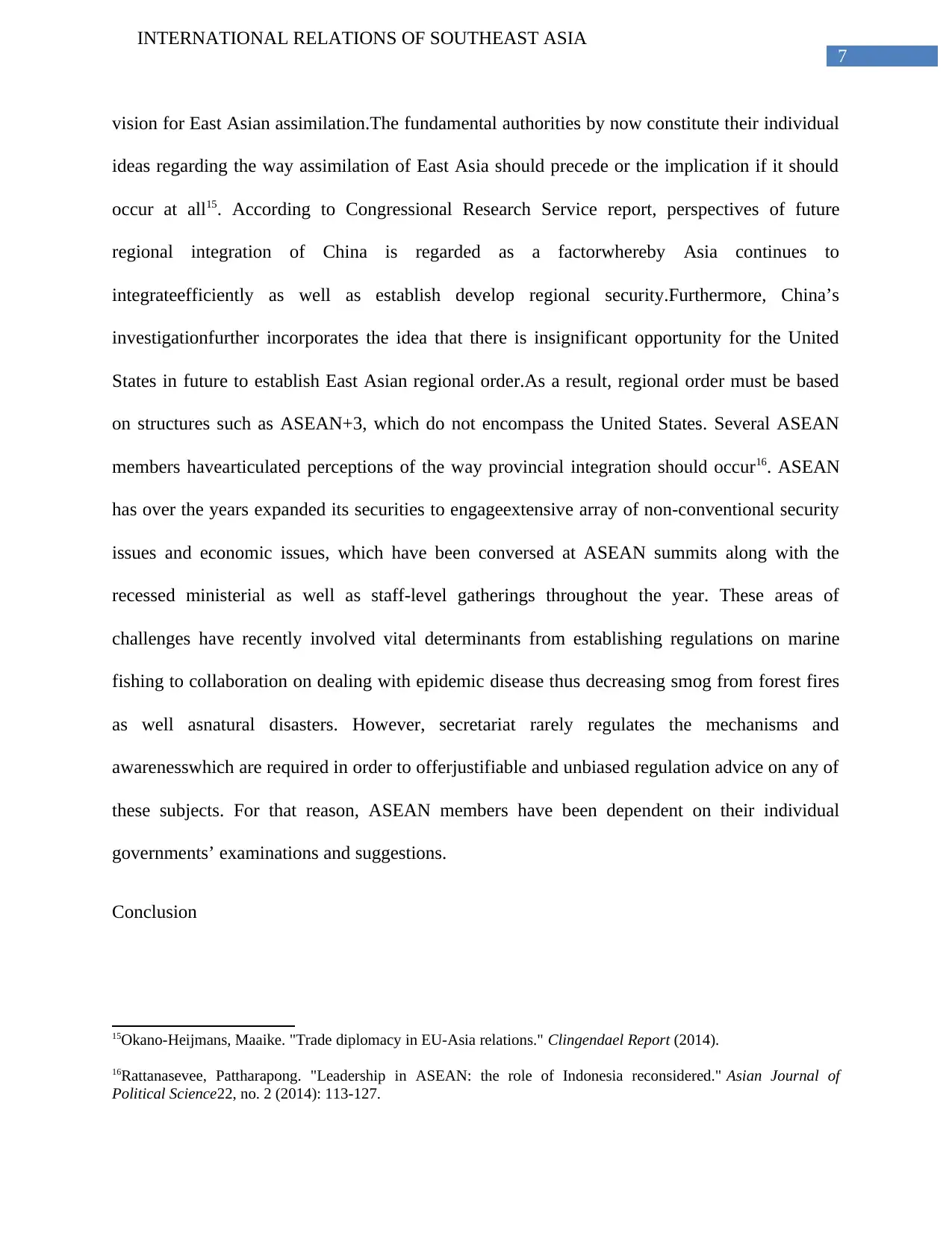
7
INTERNATIONAL RELATIONS OF SOUTHEAST ASIA
vision for East Asian assimilation.The fundamental authorities by now constitute their individual
ideas regarding the way assimilation of East Asia should precede or the implication if it should
occur at all15. According to Congressional Research Service report, perspectives of future
regional integration of China is regarded as a factorwhereby Asia continues to
integrateefficiently as well as establish develop regional security.Furthermore, China’s
investigationfurther incorporates the idea that there is insignificant opportunity for the United
States in future to establish East Asian regional order.As a result, regional order must be based
on structures such as ASEAN+3, which do not encompass the United States. Several ASEAN
members havearticulated perceptions of the way provincial integration should occur16. ASEAN
has over the years expanded its securities to engageextensive array of non-conventional security
issues and economic issues, which have been conversed at ASEAN summits along with the
recessed ministerial as well as staff-level gatherings throughout the year. These areas of
challenges have recently involved vital determinants from establishing regulations on marine
fishing to collaboration on dealing with epidemic disease thus decreasing smog from forest fires
as well asnatural disasters. However, secretariat rarely regulates the mechanisms and
awarenesswhich are required in order to offerjustifiable and unbiased regulation advice on any of
these subjects. For that reason, ASEAN members have been dependent on their individual
governments’ examinations and suggestions.
Conclusion
15Okano-Heijmans, Maaike. "Trade diplomacy in EU-Asia relations." Clingendael Report (2014).
16Rattanasevee, Pattharapong. "Leadership in ASEAN: the role of Indonesia reconsidered." Asian Journal of
Political Science22, no. 2 (2014): 113-127.
INTERNATIONAL RELATIONS OF SOUTHEAST ASIA
vision for East Asian assimilation.The fundamental authorities by now constitute their individual
ideas regarding the way assimilation of East Asia should precede or the implication if it should
occur at all15. According to Congressional Research Service report, perspectives of future
regional integration of China is regarded as a factorwhereby Asia continues to
integrateefficiently as well as establish develop regional security.Furthermore, China’s
investigationfurther incorporates the idea that there is insignificant opportunity for the United
States in future to establish East Asian regional order.As a result, regional order must be based
on structures such as ASEAN+3, which do not encompass the United States. Several ASEAN
members havearticulated perceptions of the way provincial integration should occur16. ASEAN
has over the years expanded its securities to engageextensive array of non-conventional security
issues and economic issues, which have been conversed at ASEAN summits along with the
recessed ministerial as well as staff-level gatherings throughout the year. These areas of
challenges have recently involved vital determinants from establishing regulations on marine
fishing to collaboration on dealing with epidemic disease thus decreasing smog from forest fires
as well asnatural disasters. However, secretariat rarely regulates the mechanisms and
awarenesswhich are required in order to offerjustifiable and unbiased regulation advice on any of
these subjects. For that reason, ASEAN members have been dependent on their individual
governments’ examinations and suggestions.
Conclusion
15Okano-Heijmans, Maaike. "Trade diplomacy in EU-Asia relations." Clingendael Report (2014).
16Rattanasevee, Pattharapong. "Leadership in ASEAN: the role of Indonesia reconsidered." Asian Journal of
Political Science22, no. 2 (2014): 113-127.
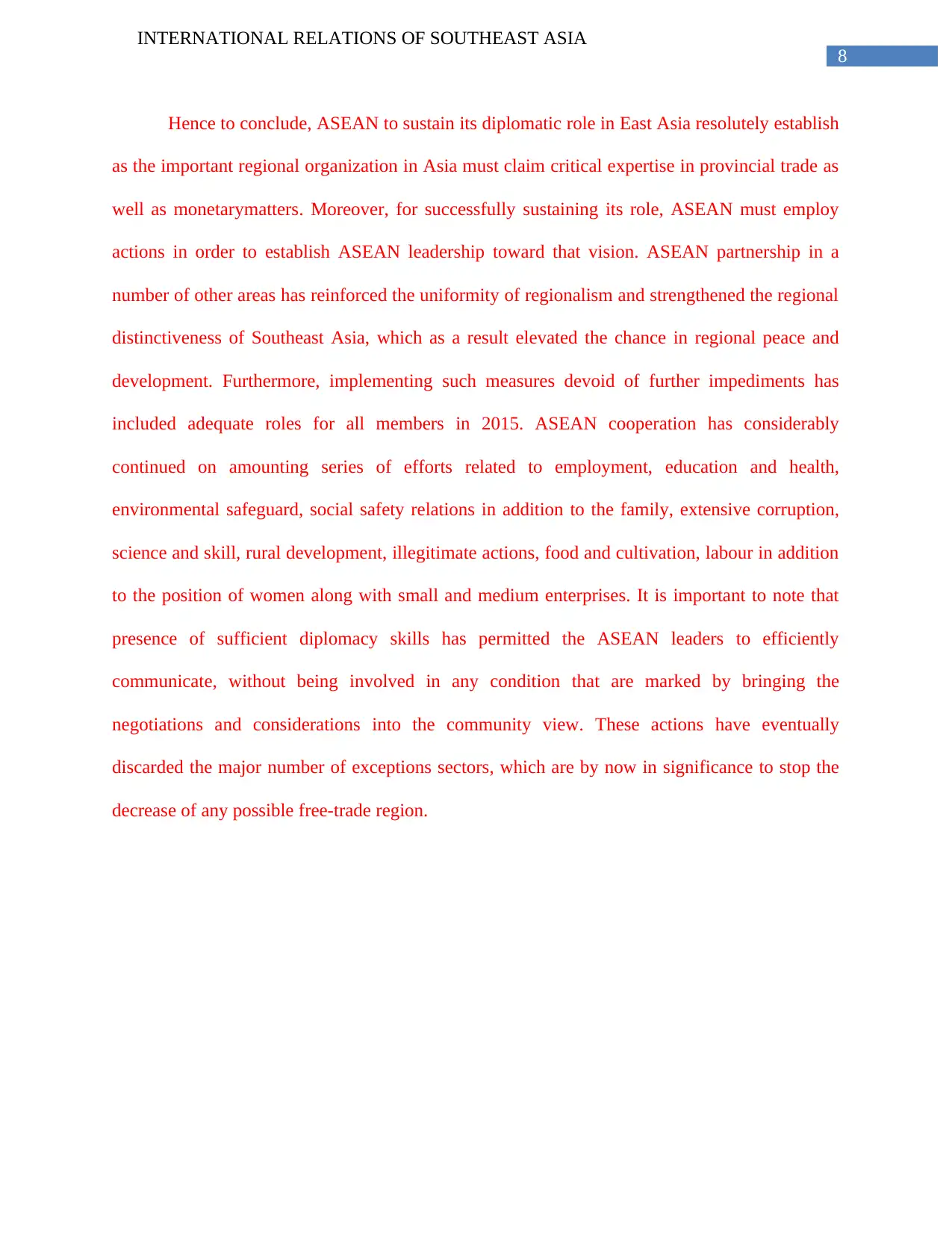
8
INTERNATIONAL RELATIONS OF SOUTHEAST ASIA
Hence to conclude, ASEAN to sustain its diplomatic role in East Asia resolutely establish
as the important regional organization in Asia must claim critical expertise in provincial trade as
well as monetarymatters. Moreover, for successfully sustaining its role, ASEAN must employ
actions in order to establish ASEAN leadership toward that vision. ASEAN partnership in a
number of other areas has reinforced the uniformity of regionalism and strengthened the regional
distinctiveness of Southeast Asia, which as a result elevated the chance in regional peace and
development. Furthermore, implementing such measures devoid of further impediments has
included adequate roles for all members in 2015. ASEAN cooperation has considerably
continued on amounting series of efforts related to employment, education and health,
environmental safeguard, social safety relations in addition to the family, extensive corruption,
science and skill, rural development, illegitimate actions, food and cultivation, labour in addition
to the position of women along with small and medium enterprises. It is important to note that
presence of sufficient diplomacy skills has permitted the ASEAN leaders to efficiently
communicate, without being involved in any condition that are marked by bringing the
negotiations and considerations into the community view. These actions have eventually
discarded the major number of exceptions sectors, which are by now in significance to stop the
decrease of any possible free-trade region.
INTERNATIONAL RELATIONS OF SOUTHEAST ASIA
Hence to conclude, ASEAN to sustain its diplomatic role in East Asia resolutely establish
as the important regional organization in Asia must claim critical expertise in provincial trade as
well as monetarymatters. Moreover, for successfully sustaining its role, ASEAN must employ
actions in order to establish ASEAN leadership toward that vision. ASEAN partnership in a
number of other areas has reinforced the uniformity of regionalism and strengthened the regional
distinctiveness of Southeast Asia, which as a result elevated the chance in regional peace and
development. Furthermore, implementing such measures devoid of further impediments has
included adequate roles for all members in 2015. ASEAN cooperation has considerably
continued on amounting series of efforts related to employment, education and health,
environmental safeguard, social safety relations in addition to the family, extensive corruption,
science and skill, rural development, illegitimate actions, food and cultivation, labour in addition
to the position of women along with small and medium enterprises. It is important to note that
presence of sufficient diplomacy skills has permitted the ASEAN leaders to efficiently
communicate, without being involved in any condition that are marked by bringing the
negotiations and considerations into the community view. These actions have eventually
discarded the major number of exceptions sectors, which are by now in significance to stop the
decrease of any possible free-trade region.

9
INTERNATIONAL RELATIONS OF SOUTHEAST ASIA
References
Acharya, Amitav. "Foundations of collective action in Asia: Theory and practice of regional
cooperation." In The Political Economy of Asian Regionalism, pp. 19-38. Springer, Tokyo, 2014.
Beeson, Mark. "Can ASEAN cope with China?." Journal of Current Southeast Asian Affairs 35,
no. 1 (2016): 5-28.
Caballero-Anthony, Mely. "Understanding ASEAN's centrality: bases and prospects in an
evolving regional architecture." The Pacific Review 27, no. 4 (2014): 563-584.
Davies, Mathew. "A community of practice: explaining change and continuity in ASEAN's
diplomatic environment." The pacific review 29, no. 2 (2016): 211-233.
Davies, Mathew. "An agreement to disagree: the ASEAN Human Rights Declaration and the
absence of regional identity in Southeast Asia." Journal of Current Southeast Asian Affairs 33,
no. 3 (2014): 107-129.
Fumagalli, Matteo. "Growing inter-Asian connections: Links, rivalries, and challenges in South
Korean–Central Asian relations." Journal of Eurasian studies 7, no. 1 (2016): 39-48.
Ma, RatihIndraswari. "Cultural Diplomacy in ASEAN: Collaborative Efforts." International
Journal of Social Science and Humanity 5, no. 4 (2015): 394.
Misalucha-Willoughby, Charmaine. How to change the game of security cooperation: The case
of the ASEAN-China strategic partnership. No. 121/2018. Working Papers on East Asian
Studies, 2018.
Okano-Heijmans, Maaike. "Trade diplomacy in EU-Asia relations." Clingendael Report (2014).
INTERNATIONAL RELATIONS OF SOUTHEAST ASIA
References
Acharya, Amitav. "Foundations of collective action in Asia: Theory and practice of regional
cooperation." In The Political Economy of Asian Regionalism, pp. 19-38. Springer, Tokyo, 2014.
Beeson, Mark. "Can ASEAN cope with China?." Journal of Current Southeast Asian Affairs 35,
no. 1 (2016): 5-28.
Caballero-Anthony, Mely. "Understanding ASEAN's centrality: bases and prospects in an
evolving regional architecture." The Pacific Review 27, no. 4 (2014): 563-584.
Davies, Mathew. "A community of practice: explaining change and continuity in ASEAN's
diplomatic environment." The pacific review 29, no. 2 (2016): 211-233.
Davies, Mathew. "An agreement to disagree: the ASEAN Human Rights Declaration and the
absence of regional identity in Southeast Asia." Journal of Current Southeast Asian Affairs 33,
no. 3 (2014): 107-129.
Fumagalli, Matteo. "Growing inter-Asian connections: Links, rivalries, and challenges in South
Korean–Central Asian relations." Journal of Eurasian studies 7, no. 1 (2016): 39-48.
Ma, RatihIndraswari. "Cultural Diplomacy in ASEAN: Collaborative Efforts." International
Journal of Social Science and Humanity 5, no. 4 (2015): 394.
Misalucha-Willoughby, Charmaine. How to change the game of security cooperation: The case
of the ASEAN-China strategic partnership. No. 121/2018. Working Papers on East Asian
Studies, 2018.
Okano-Heijmans, Maaike. "Trade diplomacy in EU-Asia relations." Clingendael Report (2014).
Secure Best Marks with AI Grader
Need help grading? Try our AI Grader for instant feedback on your assignments.

10
INTERNATIONAL RELATIONS OF SOUTHEAST ASIA
Pagovski, Zhikica Zach. "Public Diplomacy of Multilateral Organizations: The Cases of NATO,
EU, and ASEAN." Los Angeles, Figueroa Press 51 (2015): 61.
Pagovski, Zhikica Zach. "Public Diplomacy of Multilateral Organizations: The Cases of NATO,
EU, and ASEAN." Los Angeles, Figueroa Press 51 (2015): 61.
Rattanasevee, Pattharapong. "Leadership in ASEAN: the role of Indonesia reconsidered." Asian
Journal of Political Science22, no. 2 (2014): 113-127.
Roberts, Christopher B., and ErlinaWidyaningsih. "Indonesian Leadership in ASEAN:
Mediation, Agency and Extra-Regional Diplomacy." In Indonesia’s Ascent, pp. 264-286.
Palgrave Macmillan, London, 2015.
Yates, Robert. "ASEAN as the ‘regional conductor’: understanding ASEAN's role in Asia-
Pacific order." The Pacific Review 30, no. 4 (2017): 443-461.
Yates, Robert. Understanding ASEAN's Role in Asia-Pacific Order. Springer Nature, 2019.
INTERNATIONAL RELATIONS OF SOUTHEAST ASIA
Pagovski, Zhikica Zach. "Public Diplomacy of Multilateral Organizations: The Cases of NATO,
EU, and ASEAN." Los Angeles, Figueroa Press 51 (2015): 61.
Pagovski, Zhikica Zach. "Public Diplomacy of Multilateral Organizations: The Cases of NATO,
EU, and ASEAN." Los Angeles, Figueroa Press 51 (2015): 61.
Rattanasevee, Pattharapong. "Leadership in ASEAN: the role of Indonesia reconsidered." Asian
Journal of Political Science22, no. 2 (2014): 113-127.
Roberts, Christopher B., and ErlinaWidyaningsih. "Indonesian Leadership in ASEAN:
Mediation, Agency and Extra-Regional Diplomacy." In Indonesia’s Ascent, pp. 264-286.
Palgrave Macmillan, London, 2015.
Yates, Robert. "ASEAN as the ‘regional conductor’: understanding ASEAN's role in Asia-
Pacific order." The Pacific Review 30, no. 4 (2017): 443-461.
Yates, Robert. Understanding ASEAN's Role in Asia-Pacific Order. Springer Nature, 2019.
1 out of 11
Your All-in-One AI-Powered Toolkit for Academic Success.
+13062052269
info@desklib.com
Available 24*7 on WhatsApp / Email
![[object Object]](/_next/static/media/star-bottom.7253800d.svg)
Unlock your academic potential
© 2024 | Zucol Services PVT LTD | All rights reserved.